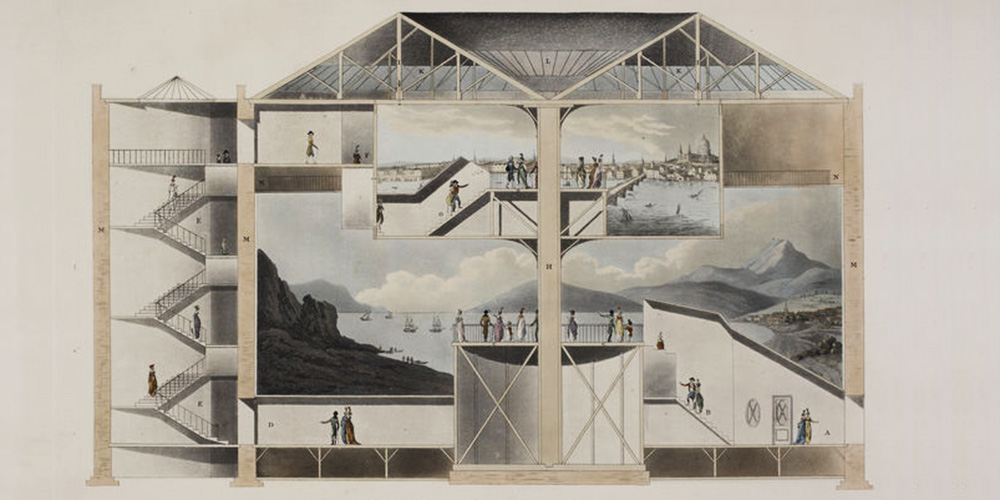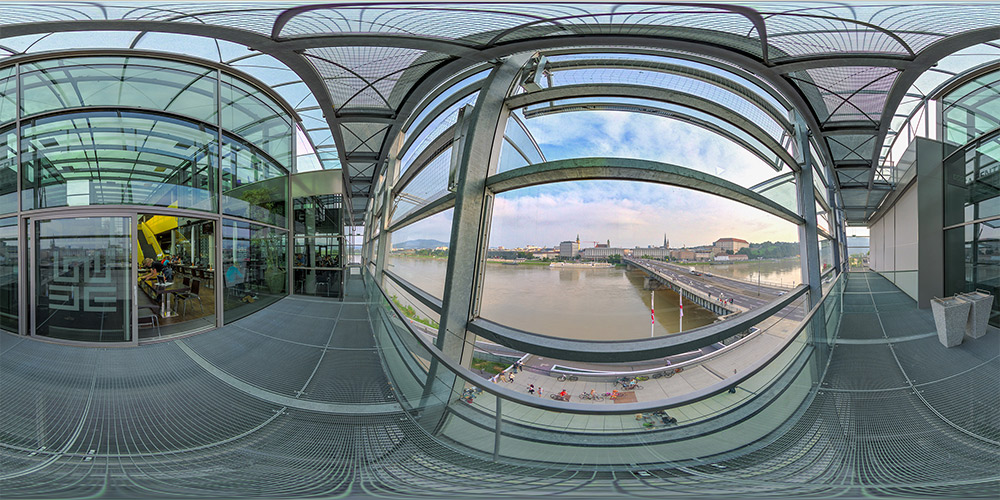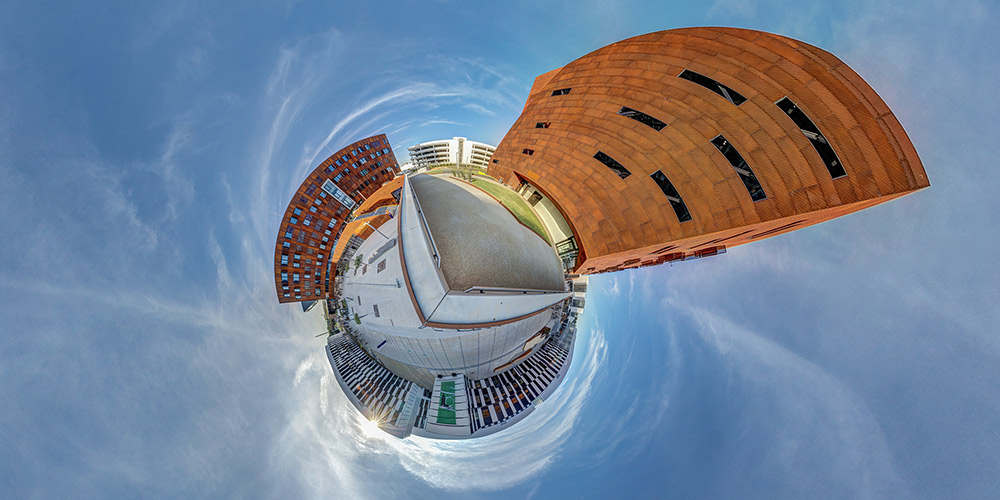Thomas Bredenfeld, expert in the field of panoramic photography and author, talks about the fascination of wide-format pictures and how these can be created today. Panoramic images do not only exist since the digital photography. Thus, already in the 18th century, the Irish artist Robert Barker experimented with panoramas and even built a panoramic house in London, where people paid admission for being able to look at the huge panoramic picture. On THU December 12, 2013 the Deep Space of the Ars Electronica Center transforms itself into a modern panoramic house when Thomas Bredenfeld talks about the current possibilities of this “borderless” photography during a Deep Space LIVE.

Why do you think are people so fascinated about panoramic images?
The fascination is certainly the view without boundaries. When we look at photographs or images we are used to see and to think these in cutted details while we as human beings normally see any borders. We have a relatively large angle of view with about 180 degrees, that not always displays object sharply but allows us to capture motions. Thus, the panoramic photography comes closer to the human vision than the actual photography, because the framing is not so strong. That fascinates us human beings. We’re built to do so – and that is banal: Our cervical spine is a vertical axis of rotation and so we look a lot more in width and in the horizontal. Vertical panoramas, however, confuse us very quickly.
You have studied painting and electrical engineering – two quite contray courses of study, but with your work you stich them together again. What connections are there between art and technology for you?
This is a good synthesis. For me it was not easy to get them under one roof, but the panoramic photography gives me a great mix: I have to do with mechanical, optical and physical things, and nevertheless have to have a creative eye – even with regard to the panoramic viewpoint. This goes on with the computer image processing and into the direction of interactive technologies. That’s when the one half of my brain comes into operation, which has previously delt with electrical engineering and now programs interactive formats with these pictures. This duality or the combination of technology and design is a very balanced utilization of both hemispheres. This is something that I like very much. Panoramic photography is a very beautiful thing.

Photo: Thomas Bredenfeld
Meanwhile, panoramic images are also arrived on our smartphones – we press a button, swing the smartphone from left to right at free hand and let it calculate a wide panorama. How much “human” does it take today to create panoramic images?
I once made a contribution to the publisher Galileo Design where I have published my book „Digitale Fotopraxis Panoramafotografie“ for the YouTube channel „Blende 8“. There, I ‘ve experimented in a workshop with panoramic photography and iPhones. Now, there is the right hardware available, there are programs without end. It’s an ambivalence between toys and seriousness nowadays. I tried to really make professional panorama shots with the iPhone – that works too. For many, it was formerly the compact camera and now there are the smartphones with their apps that are able to do such things. Many people approach on this way to the topic. For Facebook and Tumblr the pictures are quite good, but after you have realized that adjustments are necessary and the exposure is not perfect, people start to deal with it seriously and then it’s really going on. Of the many letters that I get, I know that many have encountered the panoramic photography on this way. The means of production is democratized – and it is increasing. Hardware and software manufacturers are noticing the trends in the market not as hype as it was with HDR. Panoramic photography is developing very smoothly.

Photo: Thomas Bredenfeld
How can panoramic images be created?
There are various ways – from traditional cameras and image capturing to professional scanner cameras that make the picture one go. But the latter starts from the five-digit euro range. In between, there are many possibilities. Most people first take their own camera, mount it on a tripod and rotate it. Then there are the first mechanical things that you have to consider. Furthermore, there are people who make freehand panoramic images on the mountaintop – which usually goes well, because you don’t have a foreground. There is thereby an optical problem which I mention during Deep Space LIVE, which can be seen relatively well. And then you have to put together the pictures and it depends on your lens, what camera you’ve used, how many pictures you have and if you want to create a sphere or a cylinder. There are several decisions concerning the format. It always begs the question: What do I really want to do with them? What is a good position for my panorama picture?
We don’t have any cutting on the panoramic image and is therefore my decision is not about the cut but about the position. It is a very nice spatial practice. You have to get the feeling for the space in which you stand. You have to think in 3-D instead of 2-D in photography. This is very challenging. There are subjects that can be quite boring for a normal photo, but are great for a panorama. The position also distinguishes good from bad panoramic images. At the end there is relatively much technology. The simplest way to stitch the pictures are programs that you simply feed with picture and the result is a single picture. One can also work with Photoshop, not particularly good, but it works. And then there are professional programs that cope with any kind of pictures and deliver absolutely perfect results. However, they of course require intensive learning and some skill, like all professional works.
Concerning the equipment – it is also that you can spend quite a lot of money for this over time like scanner cameras or camera robots that record the pictures automatically. I’ll bring in a handy little setup to Deep Space LIVE, so you can get a first impression of the necessary equipment, which often baffled many people. When I take pictures with it open-air, passers-by often ask me: “Oh, what are you doing here?”

Photo: Thomas Bredenfeld
If you want to show your panoramic photos – what medium is most suitable for it?
Mostly I ‘m looking at the photos on the screen. The print has its appeal, if one makes mountain panoramas, for example, this is very suitable for an extreme wide-format printed. However, the medium most commonly used is the interactive presentation – either as cylindrical panorama, 360 degree view or as a full spherical representation. The latter is the most interesting , since a truly complete and perfect sphere is generated from the point of view on which I stood. I can look up and down without restrictions, because in this view tripod and photographer are being digitally removed from the picture.
The most common use is to move with Interactive Imaging in these “virtual” spaces. You stand at a “virtual” point and see realistic representations of space. This is perfect to look at a certain location, and you can relate these things interactively. This is where the programming comes into play and you produce multimedia applications to move through a house or a company for example. The panorama is processed in the web as a collection of pictures that will be loaded only when they are needed for viewing. Here there is very much on the move, the market for it is available and I’m currently working for this professionally. And because Flash slowly disappears from the Web, open standards are increasingly coming to light. There are always more things possible that were not accessible before, and you no longer have to fear that many people can not view the panoramas for technical reasons at home. Multimedia content on the web is slowly getting better. This is the most exciting output nowadays.
On THU December 12, 2013, Thomas Bredenfeld is guest of a Deep Space LIVE at the Ars Electronica Center Linz and presents a selection of his panoramic pictures on the 16 by 9 meters large presentation wall in Deep Space.
